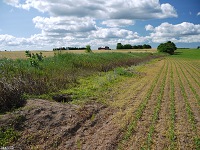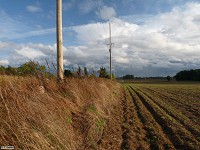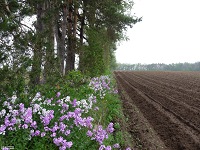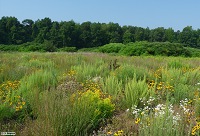Badgers and Farming
 More land in southern Ontario is devoted to agriculture than any other land use, so it's not surprising that farming has a large impact on badgers. But contrary to popular opinion, our work suggests that badgers and farming rarely come into direct conflict with each other, and that they may actually be quite capable of living alongside each other.
More land in southern Ontario is devoted to agriculture than any other land use, so it's not surprising that farming has a large impact on badgers. But contrary to popular opinion, our work suggests that badgers and farming rarely come into direct conflict with each other, and that they may actually be quite capable of living alongside each other.
But that doesn't mean that there are no reasons for concern. It is only under certain conditions that farming creates habitat that is suitable for badgers, and there are also many other challenges facing badgers in Ontario beyond the quantity and quality of habitat. However, what this does mean is that all the ingredients for successful badger conservation might already be present, and that conservation may be achieved in a way that is both consistent with, and complimentary to, the interests of farming.
What to do if you find a badger?
If you find a badger or a badger burrow on your property there is one simple step that will suffice in nearly every case: Leave it Alone. If it's a burrow that you have found, pay attention not to damage it. Usually this is very simple, but in some cases may require you to go several feet out of your way. As long as you're being attentive and using common sense, it is very easy to avoid damaging a badger burrow.
And of course, we are always interested in hearing about sightings of badgers or burrows. You can report a sighting either by phone (1-877-715-9299 toll-free) or email.
Where are badgers found on farms?
Though badger habitat can be relatively common on some farms, it doesn't actually include crop fields themselves. Rather, badger activity (i.e. burrows) is usually concentrated in the areas adjacent to the fields, where the level of disturbance is just right to allow grasses, brambles, and other wild plants to grow and go to seed. Almost every farm has some of this habitat, as a natural – but usually unintentional – byproduct of the farming process. Some examples are:
- Field and forest edges
- Old fence-lines
- Hedgerows, windbreaks, and tree-lines
- Natural area around irrigation ponds or pits
- Fallow fields and overgrown areas
The easiest kind of habitat improvement
 For those who are interested, there are some relatively simple ways to increase the amount of
habitat on your property. The easiest thing to do is preserve the habitat that's already there. This might be in the
form of an old fence-line that's become grown over, or a strip of grass and shrubs around an irrigation pond. Since
it's already there, preserving it is usually pretty simple. Next you can try to increase the amount of habitat
available. Again, starting with what you already have, leave some extra on the sides to grow wild. Even if it's just
an extra foot or two, every little bit helps.
For those who are interested, there are some relatively simple ways to increase the amount of
habitat on your property. The easiest thing to do is preserve the habitat that's already there. This might be in the
form of an old fence-line that's become grown over, or a strip of grass and shrubs around an irrigation pond. Since
it's already there, preserving it is usually pretty simple. Next you can try to increase the amount of habitat
available. Again, starting with what you already have, leave some extra on the sides to grow wild. Even if it's just
an extra foot or two, every little bit helps.
 There is a general rule of thumb to improving or creating habitat: cut/mow less often, and leave
wider edges. Many folks like to keep as much of their non-farmed land as closely trimmed as possible, to leave it looking
"maintained" and "clean". This may look nice to some people, but it's not necessarily good for wildlife.
It's only when these plants are allowed to grow, flower, and go to seed, that the real value for wildlife is
unlocked. While some people prefer the look of a short-cropped grass, you might find yourself growing more and more to appreciate the wildflowers, plant diversity, and late summer insect choruses that appear once you start leaving things alone for longer. Plus, you'll be preventing erosion, increasing access to pollinating insects, improving soil health, and saving yourself some time while you’re at it.
There is a general rule of thumb to improving or creating habitat: cut/mow less often, and leave
wider edges. Many folks like to keep as much of their non-farmed land as closely trimmed as possible, to leave it looking
"maintained" and "clean". This may look nice to some people, but it's not necessarily good for wildlife.
It's only when these plants are allowed to grow, flower, and go to seed, that the real value for wildlife is
unlocked. While some people prefer the look of a short-cropped grass, you might find yourself growing more and more to appreciate the wildflowers, plant diversity, and late summer insect choruses that appear once you start leaving things alone for longer. Plus, you'll be preventing erosion, increasing access to pollinating insects, improving soil health, and saving yourself some time while you’re at it.
Creating habitat with native plants
 Certainly the best way to improve or create badger habitat is through the use of native plants, in particular those associated with "tallgrass prairie". Being adapted
for conditions in this area, native plants bring with them many benefits. The benefits to wildlife are usually highlighted, but the advantages of using native species goes well beyond the natural world. Research has been revealing how native plants can be used reap rewards for farmers as well. For example, agriculture scientists in Iowa have discovered that interspersing tallgrass prairie strips in corn and soy fields can reduce the erosion and the loss of nitrogen by 90% and 85%, respectively.
Certainly the best way to improve or create badger habitat is through the use of native plants, in particular those associated with "tallgrass prairie". Being adapted
for conditions in this area, native plants bring with them many benefits. The benefits to wildlife are usually highlighted, but the advantages of using native species goes well beyond the natural world. Research has been revealing how native plants can be used reap rewards for farmers as well. For example, agriculture scientists in Iowa have discovered that interspersing tallgrass prairie strips in corn and soy fields can reduce the erosion and the loss of nitrogen by 90% and 85%, respectively.
While native tallgrass species are very resilient, the downside is that they can take time and effort to get established. Thankfully there are many organizations and resources that can help. Some organizations, like ALUS, may even rent marginal land from you in order to seed with native species, completely eliminating any concern for cost.
- ALUS (Alternative Land Use Services)
- Iowa State University: Prairie strips in Corn and Soy fields
- Michigan State University Prairie Strip Info
And remember, if you would like to improve habitat but for whatever reason don't want to go as far as planting native plants, simply cutting and mowing less often and leaving wider edges (as described above) is still good for wildlife.
































